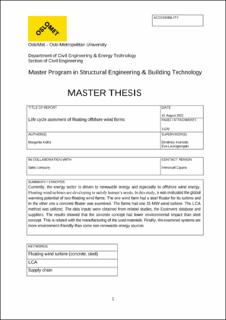| dc.contributor.advisor | Kraniotis, Dimitrios | |
| dc.contributor.advisor | Loukogeorgaki, Eva | |
| dc.contributor.author | Kollia, Margarita | |
| dc.date.accessioned | 2022-11-15T08:34:12Z | |
| dc.date.available | 2022-11-15T08:34:12Z | |
| dc.date.issued | 2022 | |
| dc.identifier.uri | https://hdl.handle.net/11250/3031806 | |
| dc.description.abstract | Socio-economic conditions and environmental concerns induced the need of renewable energy. Α continued growth of wind energy sector and specifically for offshore wind turbines is observed globally. For reasons of wind conditions and social acceptance, the turbines are placed further away from shore and different concepts are developing. In the current study, the global warming potential for the whole life cycle of two floating concepts was assessed. The one concept had a concrete support structure and the other one had a support structure made of steel. A wind farm with one 15 MW wind turbine was examined. In order to find the emissions from the two concepts and compare them, the LCA method was applied. Data were derived from related studies, from the Ecoinvent database and from suppliers. The emissions from the baseline scenarios were found to be 32.6 gCO2-eq/kWh for the steel concept and 24.3 gCO2-eq/kWh for the concrete concept. These values are lower than some non-renewable energy sources such as coal power. The main contributor in emissions is the first stage which is related with the manufacturing of the used materials. | en_US |
| dc.language.iso | eng | en_US |
| dc.publisher | Oslo Metropolitan University | en_US |
| dc.relation.ispartofseries | MABY;2022 | |
| dc.subject | Floating wind turbine | en_US |
| dc.subject | Concrete | en_US |
| dc.subject | Steel | en_US |
| dc.subject | Supply chain | en_US |
| dc.title | Life cycle assesment of floating offshore wind farms | en_US |
| dc.type | Master thesis | en_US |
| dc.description.version | publishedVersion | en_US |
